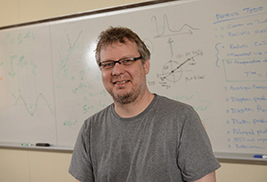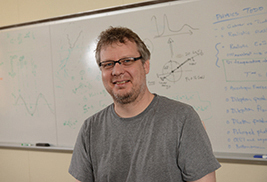Featured Article
Kent State Physics Professor Receives Department of Energy Grant to Study the Conditions of the Early Universe
A physics professor in the College of Arts and Sciences at Kent State recently received a $307,000, two-year grant from the U.S. Department of Energy.
read moreKent State Physics Professor Receives Department of Energy Grant to Study the Conditions of the Early Universe
Posted Aug. 3, 2015 | Albert Battistelli
Michael Strickland, Ph.D., associate professor of
physics at Kent State University, has received a $307,000,
two-year grant from the U.S. Department of Energy.
Strickland hopes to better understand the conditions of the
early universe and the Big Bang.
A physics professor in the College of Arts and Sciences at Kent State University recently received a $307,000, two-year grant from the U.S. Department of Energy to support the development of a novel approach to studying nonequilibrium dynamics in the quark gluon plasma (QGP).
Using a local supercomputer that he built at Kent State, Michael Strickland, Ph.D., associate professor of physics, hopes to better understand the conditions of the early universe and the Big Bang.
The grant will allow Strickland to continue the development of anisotropic hydrodynamics (aHydro) and use it to make theoretical predictions for a host of observable measurements in particle collider experiments.
“This research is important because it allows us to have a much more reliable model of the dynamics of the matter generated in heavy ion collisions and hence, the early universe,” Strickland says.
In December, Strickland and four collaborators published the first exact solution to model the conditions of approximately one-millionth of a second after the Big Bang, allowing for the study of how extremely hot QGP cools down in an environment similar to the early universe. The measurements required to conduct such experiments must be precise, and in order for Strickland to model the matter created in such experiments, advanced numerical simulations are necessary.
To read more about the exact solution, visit www.kent.edu/kent/news/kent-state-physics-professor-publishes-exact-solution-model-big-bang-and-quark-gluon.
One issue with these measurements is that QGP can have a large pressure anisotropy, which means that they can be measured differently depending on their direction. This can cause complications when trying to model it. Strickland has made key advances toward describing such inherently anisotropic plasmas. The resulting dynamical framework, dubbed “aHydro,” has a wide-ranging applicability in the theoretical study of the QGP.
Strickland is hopeful that this research will be beneficial to other fields as well.
“There are applications beyond heavy ion collisions since the method developed extends typical fluid-dynamical frameworks to situations where the fluid is far from equilibrium,” Strickland says. “This can have applications to not only fundamental physics but also astrophysics, aeronautical engineering and aerospace applications.”
To learn more about Strickland’s research, visit http://personal.kent.edu/~mstrick6.
For more information about Kent State’s Department of Physics, visit www.kent.edu/physics.
